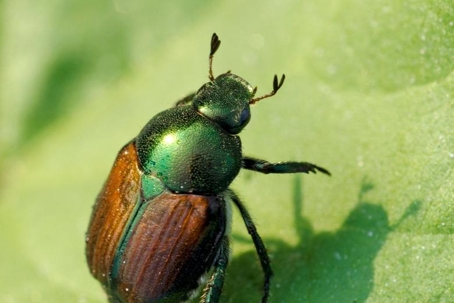Can Japanese Beetles Bite?
Japanese beetles (Popillia japonica) are not considered a threat to people through biting. While they do have mandibles (jaws) that they use to chew on plant material—specifically leaves, flowers, and fruits—they are not adapted for biting humans or animals. Their mandibles are relatively small and delicate, evolved specifically for feeding on vegetation rather than for defense or predation.
In rare cases, if a Japanese beetle lands on human skin and feels threatened, it might attempt to use its mouthparts defensively. However, this would be extremely mild—at most a slight pinch or tickle, often not even noticeable. It is not a true bite in the way you might experience from insects like horseflies, mosquitoes, or ants, which have mouthparts designed for piercing or biting flesh.
If someone does report a sensation after contact with a Japanese beetle, it’s more likely due to:
The beetle's spiny legs scratching the skin when it tries to cling or crawl.
A psychological reaction (feeling a "phantom" bite due to seeing a bug on the skin).
A mild allergic or irritant reaction to the beetle's body or defensive secretions, though Japanese beetles are not commonly associated with significant allergic responses.
Do Japanese Beetles Bite?
Japanese beetles (Popillia japonica) are highly unlikely to deliberately bite humans under any normal circumstances. However, if we speak thoroughly and professionally about when they might attempt to pinch or nibble with their mandibles, it would almost always involve situations of accidental or defensive contact, not intentional aggression.
Here are some scenarios where a Japanese beetle might try to "bite" (more accurately: test or pinch) a human:
Accidental Handling or Aggressive Contact: If a person grabs, squeezes, or traps a Japanese beetle—such as brushing them off clothing, picking them up by hand, or squishing them between fingers—the beetle may reflexively use its small mandibles in self-defense. This would be more of a reflexive defensive action than an active bite. It still would barely register as a "nip" to human skin.
Extended Skin Contact: If a Japanese beetle lands on exposed skin and remains there for an extended period, especially if trapped by clothing or if the person remains still, the beetle might explore the surface with its mouthparts. It’s important to understand that they do not "recognize" human skin as food, but may occasionally mouth or "taste" surfaces out of confusion or exploration, similar to how other herbivorous insects behave.
Presence of Strong Odors or Food Residues: If a person has sweaty skin (salty minerals) or fruity, floral, or sweet-smelling lotions (especially those containing fruit extracts or fragrances), a beetle might mistake the odor as something edible. Japanese beetles are highly attracted to sweet and floral scents, so lotions, perfumes, or fruit juices on skin could theoretically trigger exploratory chewing behavior.
Extreme Overcrowding or Stress: In very rare cases where there is an extremely high beetle population (e.g., a major infestation where the insects are desperate or stressed due to lack of food), they might behave erratically. However, even under these conditions, the likelihood of intentional biting remains exceedingly low compared to their instinctual plant-feeding behavior.
Misidentification: Sometimes reports of "bites" attributed to Japanese beetles are actually caused by other insects present at the same time, such as ants, deer flies, horseflies, or even tiny stinging insects. A customer might see a beetle and assume it caused a bite simply because of timing, but in many cases, another pest is to blame.
Japanese beetles do not actively seek out or deliberately bite people.
Any "biting" behavior is rare, defensive, exploratory, or incidental and is unlikely to cause pain, injury, or allergic reaction. The real risk of Japanese beetles is massive plant destruction, not human health threats.
Japanese Beetle Bites
Japanese beetles (Popillia japonica) are primarily plant feeders, and while they can occasionally nibble on human skin if handled, they rarely bite people. When they do, it’s typically a very minor pinch rather than a true bite with venom. Here’s what you should know about the appearance if you get “bitten”:
Pinprick or small redness: A Japanese beetle bite may look like a tiny red spot, similar to a pinprick or minor insect bite.
Minimal swelling: There might be slight swelling, but it’s usually very mild.
Itching or mild irritation: Some people experience minor itching or discomfort, but it rarely develops into a rash.
No blisters or welts: Unlike bites from mosquitoes, horseflies, or bed bugs, Japanese beetle bites generally do not form raised welts or blisters.
Because their bites are so minor, most reactions are negligible and resolve quickly without treatment. For extra caution, you can clean the area with soap and water and apply a soothing lotion if there’s any irritation.

